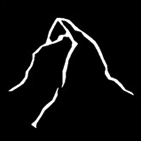Costs and Profits.
The following entries give some behind-the-scenes information on a few of my titles. Over the coming weeks I will be adding new titles. Costs (C), Revenues (R) and Profits (P) are specified for each title.
Die Wolken (2012)
C:-745* R:2242 P:1497**
Just as Der Baum (2010), this title was inspired by a booklet from the german pre-WWII -series Der Eiserne Hammer. The original booklet showed photographs of German skies and clouds, as this series was supposed to show the beauty and cultural history of the country.
My edition of 200 copies contains heavily rasterised reproductions of fighter planes, taken from a 1982 yearbook. The colors I chose for the printing are based on US fighter plane insignias and instead of printing the different colors in one zine, I decided to copy the same zine three times, each one in a different color, so there is a red, a blue and a black version. The three versions have identical covers and come as a set.
Thin newspaper stock contrasts with the violent imagery, but at the same time reminds of printed media war stories.
These booklets were printed, again, in the local offset print shop. I thought they would charge me considerably for the cleaning of the plates and changing of the inks between the three print runs, but the account manager (/receptionist /production assistant /director) offered it to me for free.
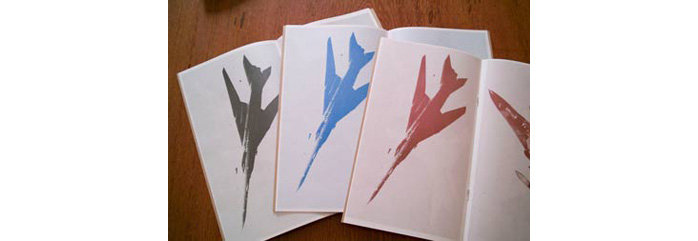
The (financial) success of this title -a 300% return on my investment!- made me want to repeat an experimental use of color in 2013, which completely crashed and turned out a financial failure:
Havaianas (2013)
C:-605* R:525 P:-80**
Oh man, I really thought that Havaianas was a great idea and would be a sure hit: So I rolled some silkscreen ink on the sole of my flip-flop (size 43) and stamped it onto paper. I then scanned the image and had it reproduced, in offset, using the CMYK colors and their respective screen angles. The positions of the 'feet' even resembled some weird Samba version and the whole publication became a sort of cultural comment / homage by using only printing techniques. A winner, right?
Now, 2.5 years after I published Havaianas, I am still short 80 euro. Ok, I did sell a few of the editions -unique stamped compositions on paper, which revenues are not included here, but still.
I am very disappointed that not more people saw the geniality in this little gem.
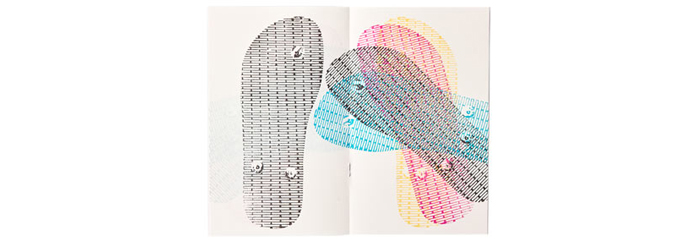
Foto.zine nr.5 -set (2013)
C:-1993* R:3657 P:1664**
This set, once more, contains five different publications in the same size, but printed on different paper. Each collection of images was photographed in Brazil and contains a subject that is not -or not any more- common in Europe.
Lixo shows a collection of rubbish bins that you can find in front of every house. People put their trash in these bins so it won't get flushed away by rain or opened easily by donkeys and rats. Interesting detail is that there is no store selling these bins, so they're all custom made.
Fusca is the portuguese word for the Volkswagen Beetle. There used to be so much more in the streets, but when the government loosened conditions on payment plans for new cars, they rapidly disappeared from sight. I photographed this set in 2003, when I was still using film. Unfortunately humidity in Brazil worked hard on the not-so-well rinsed negatives which caused them to fade.
Motel shows entrances of some motels in town. This phenomenon of the pay-by-the-hour motel is only more present in Japan. In Brazil most of the adultery and sex-before-marriage happens in these colourful settings. You enter by car and get a key handed through a small hole in the wall. When you're ready for your bill, it will also be delivered through a hole in the wall. You'll never see or interact with anyone else but your partner in a motel.
Buzios is the name of a small village just outside Natal. This village is more like a ghost town during eleven months of the year and inhabited only during summer vacation. Of course no Brazilian will spend a whole summer without their tv, hence the huge parabolic antennas on the roofs.
Jardins is the name of a posh neighbourhood in Sao Paulo where everybody lives in gated apartment buildings. The little guard houses, equipped with bullet proof glass, are usually built in the same style as the residential building, so the owners don't notice them or feel as if they're living inside a prison.
The foto.zine nr.5 -set was printed in Brazil, at three different local printers, in an edition of 400. This way I could use the quotes between them in order to each offer me their best prices. The papers used range from 55grs newsprint to 90grs Polen, so each issue has a specific touch to it. To emphasise their collectible and collective character I chose to only sell them as a set. I am sure that 1 + 1 + 1 + 1 + 1 = more than 5
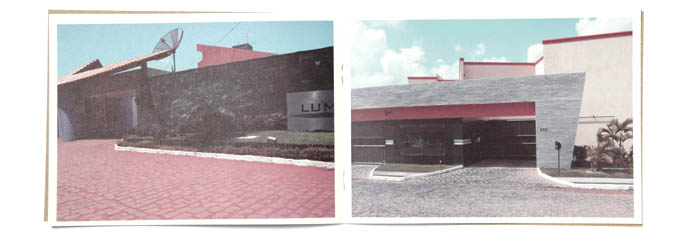
Contemporary Brazilian Politics (2011)
C:-243* R:856 P:-243** (revenues + costs all donated)
One of the things that strikes me most as a European in Brazil is not the daily report on corruption, with politicians stealing from public funds, but the fact that the population doesn't seem to rise up against this. (There seems to be a general apathy towards larger societal issues, but its deeply rooted causes are not part of this text.)
For a while I had been collecting excerpts from international newspapers, online, about corruption in Brazil. For Contemporary Brazilian Politics I decided to publish parts of phrases from these clippings, not mentioning any name or specific case. I printed the text in white on a black background and used 100% of ink printing on thin newspaper stock. This paper is not able to absorb all the ink, so there's a little bit left behind on the paper, which will rub off on the reader's fingers.
When I set the sales price for C.B.P. I realised I didn't want to earn any money on this subject, so decided to donate all revenues to a social project in our town, that works with children in a Favela. A tiny percentage of the money stolen by politicians from these kids' futures finally reaches the children through this printed detour. When the dance group in this project needed fabrics for their Christmas presentation outfits, I decided to donate the printing costs I had invested in C.B.P. as well.
I don't believe that artist's books can change the world, but I do believe that tiny gestures can add up and make a difference.
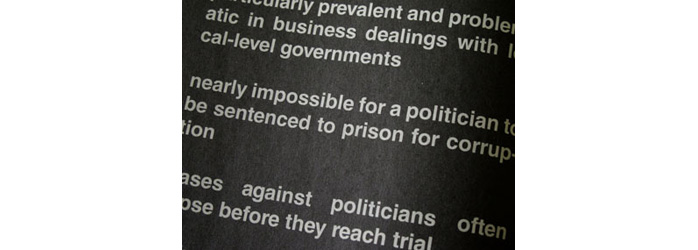
Parking Lot (2011)
C:-255* R:1302 P:1047**
The jet lags in Japan can be really hard. I arrived in Ota-ku, a commuter ward in Tokyo, in January 2011 and had trouble sleeping. The internet in my house wasn't working yet, so the nights were pretty long. I started making night walks in the neighbourhood, snapping some pictures on the way. After a few nights I had almost a hundred photos of parked cars with impeccable interiors, fit tightly into their tiny pre-fab garages.
The series that grew in my mind and on my memory card was in a way related to Ed Ruscha, but was also fruit of a personal experience in strange place far from home.
I reached out to some friends in a graphic design company in Tokyo, to help me produce a small publication of this series and they got me in touch with a printing company in Osaka, that still did (image) letter press printing. Together with the designers, whom I had asked to also design the cover, we decided on a paper commonly used in Japan for Manga comics. After sending some samples back and forth we chose the raster, ink and paper for the cover and set the edition size of 200 copies, at €1 production costs per copy. (After the great Earthquake hit and I had to leave Japan, it cost me another €55 to ship the copies to Europe.)
This little publication is still one of my favorites, because of its simplicity, cultural references and personal memories I have of its production.
Maybe also a little bit because of the 500% return on my investment. I wished I'd had invested more.
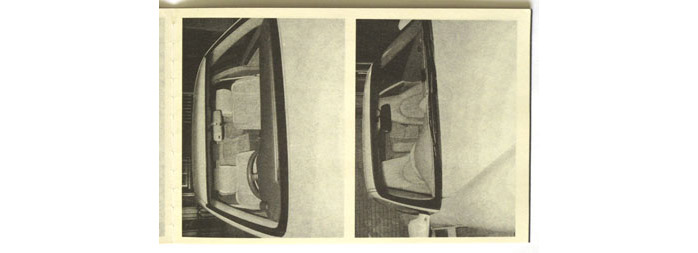
Foto.zine nr.4 -set of 5 (2011)
C:-4365* R:6462 P:2097**
I had successfully contacted all the five artists on my list for the foto.zine nr.4 -series, but it took a while to get Takashi Homma's material due to his busy schedule. So when I finally had everything together, I went on print that same week. In my rush I had not chosen the right paper for the covers and inside, which I only noticed it when I received all 2000 copies of the five zines. The overall printing quality from this Brazilian printer wasn't great either. I didn't sleep well that night, because I had screwed up and fucked up the work of other artists.
The next day I decided to take my losses and print everything again at a higher quality (and way more expensive) printer in the Netherlands. Even with the total €4, that a recycling company gave me for the 2000 copies of that first print-run, I had a hard time breaking even on this project. In the end the quality of this publication contributed to this set becoming a steady seller at art book fairs, were it even got praised for the paper and reached a final 'profit' of €2000.
Or, €1 per thrown-away copy from the first print-run.

Nelore (2012)
C:-620* R:1386 P:766**
Every year in October there is a ten day cattle fair and exhibition in our town. I usually go there twice, first with my wife and son and we dream out loud of owning some of the beautiful horses and cows. The second visit I take only my camera and photograph many of the animals.
Nelore beef cattle was originally brought to Brazil from India. The Nelore has a distinct large hump over the top of the shoulder and neck. They have long legs which help them to walk in water and when grazing. The Nelore can adapt to all except very cold climates. Brazil is the largest breeder of Nelore.
The ladies in this zine are the contestants for the 2010 beauty contest, so they are well groomed and perfumed. Their pedigree and beauty will send their genes to many Brazilian tables during lunch hour, but for the moment they just have to look pretty.
At my local printer I had found a paper that was so roughly recycled that there were still particles of plastic and sometimes even metal in it, with a very coarse feeling to it. This yellow paper is usually used as a cover for waiter notebooks in cheaper restaurants and is called Capa (=cover) AG.
Nelore was printed on this paper in an edition of 400 of which I managed to distribute 300 copies quickly and I kept the last box in my studio, for future re-stocking. By the end of 2013, when I needed the last copies and opened the box, humidity had glued them all together and made them unrecognisable. The fire they went in that evening became pretty smokey and we were freed of mosquitos for almost a week.
Still, the profits of Nelore have bought our family roughly 135kg of Rump Steak. Bon appetit.
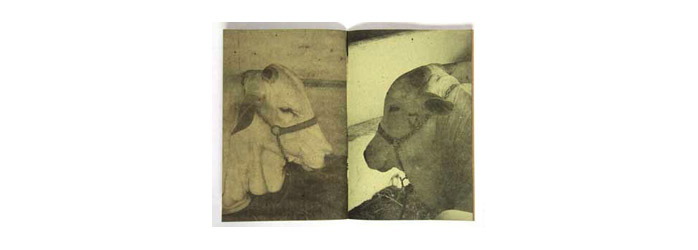
Bonsai (2011)
C:-2826 R:3284 P:458
During a residency in Tokyo, Der Baum was still going strong in sales. Inspired by Japan I decided to make a book that was related to Der Baum, but was also the complete opposite. Where Der Baum dealt with subject matter, history and (hidden) stories, Bonsai had to deal with the image and the book as objects. Both titles have exactly the same size and similar design and in some ways complement each other. For Bonsai I re-photographed the pictures in a book I had bought on a Korean (!) flea market, many years before. I digitally transformed the images into black and white negatives, so to emphasise their constructed, object-like quality. I invested all the profits Der Baum had generated until then in the production of Bonsai, especially the Japanese thread binding and semi-matte varnish over the images.
I had really thought this publication could cross-over from the artist's book audience and infiltrate between the coffee table books. Truth is Bonsai took almost 4 years to break even and never got really noticed. Similar to a very, very small tree.
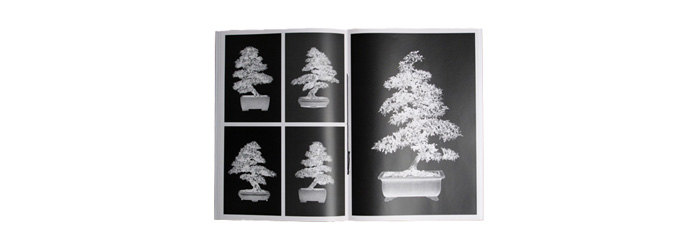
Souvenir III (2013)
C:-1035* R:1880 P:845**
When I photographed the 22 prostitutes for Praia, back in 2003, I used a Contax T2 with color film. But I also had an Olympus mju on hand, loaded with b/w film, which I used for the in-between scenes. Overexcited as I was with the results from the T2, I didn't even look at the b/w contacts until recently, when I found them hidden in a moving box in my storage unit. Of course the pictures were much less composed than the colored ones, but there were quite a few of them interesting enough to enlarge. Going through the work, so many years later, I had a lot of Oh-Yeah! moments, like going through one's childhood album. I ended up choosing 35 images which printed in offset on card stock, to resemble postcards, and had 100 pink binders produced and silkscreened in the Netherlands. It took me three full days to put all the cards in transparent sleeves and finish each binder. If I divide the income of this title by the three days -or 24 hours- assembling, I made €35 an hour for those three days, which is similar to what a Nuclear Power Reactor Operators makes.
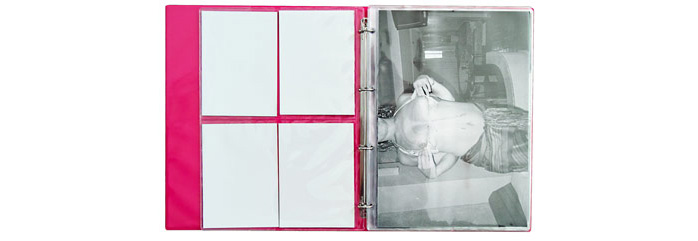
Privacy Settings (2013)
C:-1912 R:1500 P:-412
It took me almost eight years to prepare myself emotionally to publish this title. I had photographed my son, while he was sleeping, over the course of one month. I imagine many parents look into their children's bedroom to check on them -or just to smell them- before going to bed. I don't think many parents decide to photograph their sleeping children and then print the images in a book and publish that as a work. So, as I said, it took me until 2013 to decide to actually publish a work I had finished many years earlier. On the day I had to upload the files to the printer I decided I wanted the images to rotate a few degrees, so that in the end the images on the pages, throughout the book, had made one complete turn. One child, one month, 360 degrees. Could have been any child, could have been any month, could continue endlessly. I was and still am aware of the high Why-would-I-care-about-your-kid's-pictures factor in this book, but I think I covered that in the title, Privacy Settings. On social media both adults and teens can go very far in exposing their private lives, especially through pictures. What used to be confined to a family album, shown on special occasions to special visitors, has become a common daily practice in the 2000s.
I am very pleased when artists and curators praise and buy the book and understand it for what it means and for what it could mean. Unfortunately Privacy Settings is the worst selling title from my catalogue. It hasn't made one step outside of the small artist/curator/collector community and sofar has only cost me money, the equivalent of a bit under €14 per picture of my sleeping son.
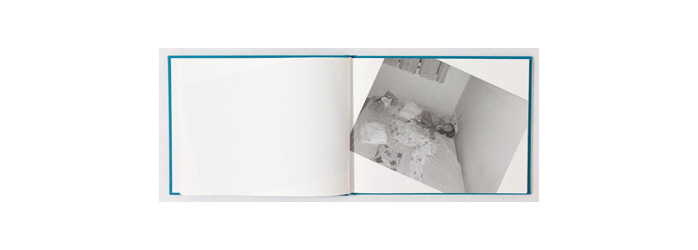
O.Niemeyer (2012)
C:-6337 R:10638 P:4301
The book O. Niemeyer was ready to go on press. It had been in project-stage for almost year and I had set a soft deadline for its release. Still, something was missing, I felt.
I had photographed many of Oscar Niemeyer's buildings over the past six years, most of them in Brazil, but also all of his main-land European projects. Then, three days before uploading the files to the printer in Tallinn, I realised: I hadn't included the Pampulha project. A group of buildings around an artificial lake in the outskirts of Belo Horizonte, comissioned by mayor Juscelino Kubitschek in the 1940s, who would later, as president, commission the new capital Brasilia.
I vaguely remembered the first time I visited the Pampulha lake in 1995, during my first stay in Brazil. My best friend Tatiana had invited me to come visit Belo Horizonte and stay on her family's estate in the Pampulha neighbourhood. One morning we went for a walk along the lakeside and got as far as Niemeyer's St. Francis church, after a breakfast of pão de queijo and screwdrivers. Years later I realised that that morning had been my first encounter with (tropical) modernism and also had been a turning point in my personal life. In retrospect, that first encounter with Niemeyer's work was the basis for my decision to become an artist.
So, of course I had to include Pampulha in my Niemeyer book. I bought a plane ticket for two days later and spent that day photographing as many buildings by Niemeyer in Belo Horizonte as I could. I flew back home in the evening after a tiring, but satisfying 18 hours. I notified the printer the next day that I would need an extra 16 pages and now, three years after the first edition of O. Niemeyer was released, I still believe that going that extra mile in any book project pays itself back exponentially. Also, that extra shooting day including the flights, had cost me 8% of the project's profit until now.
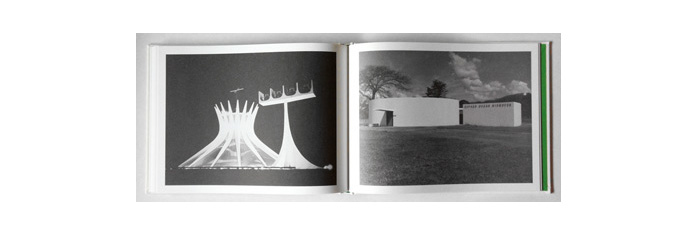
(suggested further reading: Prostitution, Art Books & Marketing)
*Costs are (offset) production costs only (offset printing and binding), all in euro's.
**Profits are based on sales minus production costs and do not take any other costs, such as transport, fees or overhead into consideration.
|
